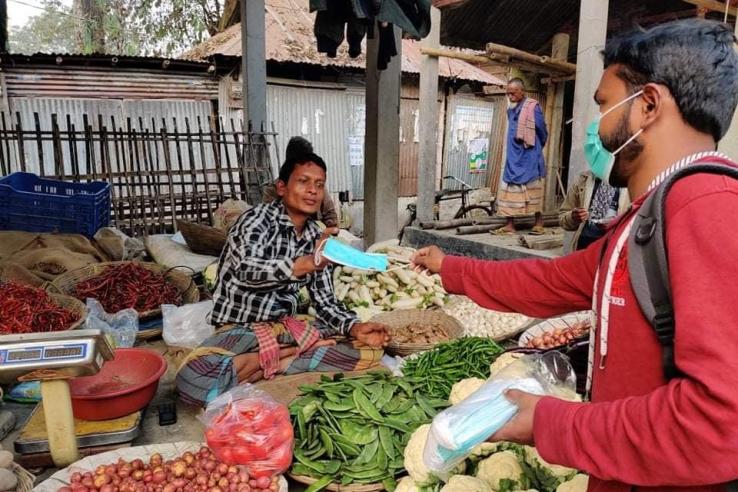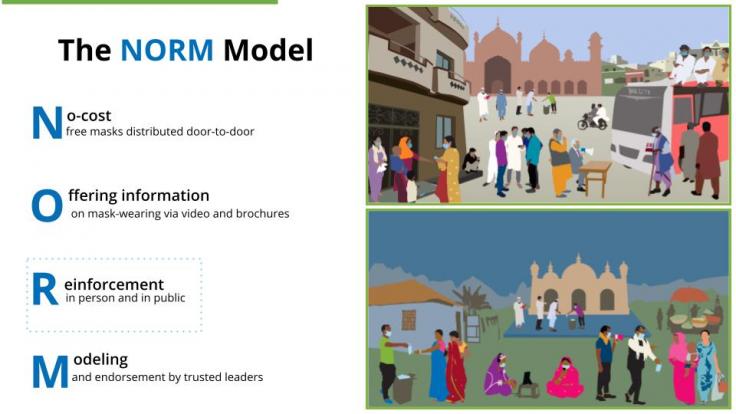Normalizing mask usage to combat Covid-19

The Covid-19 pandemic has taken the lives of more than 4.5 million people globally.1 While face masks can slow the spread of the disease and save lives, getting people to consistently and properly wear masks has been a major public health challenge. A randomized evaluation of community-level mask promotion in rural Bangladesh during Covid-19 showed that the intervention tripled mask usage and reduced Covid-19. The program is now being scaled up to reach millions of people in Bangladesh, India, Pakistan and Nepal.
The Problem
Evidence shows that face masks can slow the spread of Covid-19 and save lives, but mask usage remains low across many parts of the world, and strategies to increase the use of masks remain untested.
The Covid-19 pandemic has taken the lives of more than 4.5 million people globally.2 While vaccines may offer a long-term solution, widespread vaccination in low-income countries may be more than a year away and new, more contagious strains continue to emerge. Meanwhile, laboratory studies have established the potential efficacy of face masks as a means to control transmission, blocking particles emitted by infected individuals.3 In addition, since a substantial share of coronavirus transmission is due to asymptomatic or pre-symptomatic individuals, universal mask-wearing, rather than only symptomatic mask-wearing, has the potential to dramatically slow the spread of the virus.4
While face masks can slow the spread of the disease and save lives, getting people to consistently and properly wear masks has been a major public health challenge. Until the virus is eradicated globally, protective behaviors like mask-wearing remain critical. Therefore, determining scalable and cost-effective means of promoting mask use, as well as measuring the impact of these interventions on proper, consistent usage and physical distancing behavior is of first-order policy importance.
In Bangladesh, researchers partnered with policymakers and local NGOs to design and evaluate strategies to increase mask uptake. Bangladesh, as the eighth-most populous country in the world (approximately 166 million people), is a key country in the global fight against Covid-19.5 It is also one of the most densely populated countries, making Covid-19 prevention measures such as physical distancing extremely difficult to implement.6 Despite the recommendations of health experts and a government policy requiring the use of masks, observational studies documented a decline in mask-wearing in Bangladesh between May and June 2020.7
The Research
A large-scale randomized evaluation helped identify an effective model to increase mask-wearing and reduce transmission of Covid-19 in Bangladesh.
In April 2020, a multidisciplinary team of researchers, including J-PAL affiliate Mushfiq Mobarak (Yale), and staff from Innovations for Poverty Action (IPA), partnered with Bangladeshi policymakers—including The Ministry of Health and Family Welfare, The Bangladesh Medical Research Council, and Access to Information (a2i)—and the local NGO GreenVoice, to rigorously test various strategies to increase mask-wearing at a large scale.89 These efforts built on existing relationships with key policy stakeholders in Bangladesh, as well as the expertise of Bangladeshi researchers, which presented a unique opportunity for new research and ensured that recommendations were both tailored to the context and responded to policy-relevant questions.
This partnership resulted in the development of the “NORM” intervention, which consists of a series of strategies to promote mask usage, including free household distribution of surgical or cloth masks, information, and reinforcement. For more details on the different strategies tested, see this project summary.10

Results showed that the NORM intervention more than tripled mask usage. In villages that received the intervention, mask use increased by 29 percentage points (a 223 percent increase from a comparison group usage rate of 13 percent). This impact persisted at least ten weeks after the intervention activities ended. Contrary to concerns that mask-wearing would promote risky behavior (giving people a false sense of security and reducing physical distancing) the study found that the intervention increased physical distancing.
In-person reinforcement and monitoring were an essential part of the NORM intervention. Researchers found that proper mask-wearing increased by 28 percentage points when masks were not only distributed but promoted and their use was reinforced. By contrast, none of the community or household-level behavioral interventions or incentives (text message reminders, public signage, monetary and non-monetary incentives, altruistic messaging, or verbal commitments) led to additional increases in mask-wearing or physical distancing.
Finally, reusable surgical masks were as likely to be adopted as cloth masks. This is an important finding given surgical masks are one-third the cost of cloth masks and have much better filtration efficiency. Overall, implementing these interventions—including distribution of free masks, the information campaign, reminders, and encouragement—cost US$2.75-US$4.93 per person per month. At scale, these costs would be significantly lower, with one NGO in India estimating that, to reach around 3-4 million people, the cost per person per month would fall to US$1.00. Although lockdowns produce around three times the benefit of the NORM intervention and may be necessary when cases soar, they cost dramatically more and may be unsustainable in economies like Bangladesh where the majority of the population are daily wage earners. Normalizing masking can reduce the need for lockdowns while saving lives.
Results from a ten-week follow-up survey revealed even more promising results: researchers found that free mask distribution and promotion reduced the proportion of people who reported Covid-19 like symptoms by an average of 11 percent. About a third (40 percent) of those who reported Covid-19 symptoms agreed to have their blood tested for the virus. On average, researchers found a 9 percent decrease of Covid-19. This reduction was higher in villages where residents received surgical masks and in these, among individuals aged 60+.
For more details, see the evaluation summary.
From Research to Action
Drawing on these results, various governments and non-governmental organizations are supporting the scale-up of the NORM intervention across South Asia.
Based on the evaluation’s results, multiple organizations are currently replicating the NORM program in different contexts, reaching millions of people in Bangladesh, India, and Pakistan.
- Bangladesh: BRAC—the largest non-governmental organization in the world—began implementing NORM in 35 high-risk districts. As of August 2021, over nine million people had received masks through distribution campaigns in households, hotspots, or other public spaces. The Shakti Foundation also aims to replicate the intervention to reach an additional eight million people in Bangladesh.
- India: The Self-Employed Women's Association (SEWA) scaled up the NORM approach to 13 districts in Gujarat and, as of August 2021, have distributed masks to 250,000 people. SEWA is scaling the program across Gujarat and other states in India to reach one million people by October 2021.
- Pakistan: The City Administration of Lahore began implementing the NORM program in June 2021 and has reached four million people. The program was noted as the first policy priority in a recent nationwide Covid-19 mitigation strategy and is expected to expand across the country.
- Nepal: The NORM model was launched in 3 hotspot municipalities (Thimi, Sunsari and Melamchi) in October 2021. So far, 450,000 masks have been distributed by the local partner Covid-19 Rapid Action Taskforce (C-19 RAT), a coalition of organizations that have expertise in volunteer mobilization and disaster relief work. The pilot will continue throughout the country across the 276 municipalities with 1 million masks donated by Hanesbrands in the US.
“We are happy to report that this study done by a Bangladeshi-American economist, Professor Mushfiq Mobarak, and his colleagues, provides exactly the kind of rigor that is required for policymakers in the global south who are focused on a fine balancing act of saving lives and livelihoods."– Asif Saleh, Executive Director, BRAC Bangladesh
To help partners with their scale-up efforts, the NORM team continues to offer the following support to implementing partners:
- Advising organizations on how to identify high-quality surgical masks and which manufacturers to procure them from;
- Providing locally-contextualized communications materials, including videos and flipcharts, and scripts for promoters, reinforcers, and trusted leaders to use when promoting mask-wearing;
- Sharing and providing support to contextualize a detailed implementation toolkit, with a step-by-step protocol for the implementation of the intervention;
- Monitoring program rollout, including the creation of an app and dashboard to track mask-wearing; and
- Offering advisory support in planning for and implementing the NORM intervention.
References
Abaluck, Jason, Laura H Kwong, Ashley Styczynski, Ashraful Haque, Md. Alamgir Kabir, Ellen Bates-Jeffries, Emily Crawford, Jade Benjamin-Chung, Salim Benhachmi, Shabib Raihan, Shadman Rahman, Neeti Zaman, Peter J. Winch, Md. Maqsud Hossain, Hasan Mahmud Reza, Stephen P. Luby, and Ahmed Mushfiq Mobarak. “Normalizing Community Mask-wearing: A Cluster Randomized Trial In Bangladesh.” Working paper, April 2021. https://doi.org/10.3386/w28734
Abaluck, Jason, Laura H Kwong, Ashley Styczynski, Ashraful Haque, Md. Alamgir Kabir, Ellen Bates-Jeffries, Emily Crawford, Jade Benjamin-Chung, Salim Benhachmi, Shabib Raihan, Shadman Rahman, Neeti Zaman, Peter J. Winch, Md. Maqsud Hossain, Hasan Mahmud Reza, Stephen P. Luby, and Ahmed Mushfiq Mobarak. “The Impact of Community Masking on COVID-19: A Cluster-Randomized Trial in Bangladesh.” Working paper, August 2021.
https://www.poverty-action.org/sites/default/files/publications/Mask_RCT____Symptomatic_Seropositivity_083121.pdf
Abdul Latif Jameel Poverty Action Lab (J-PAL). 2021. "Normalizing mask usage to combat Covid-19." J-PAL Evidence to Policy Case Study. Last modified October 2021.
Center for Systems Science and Engineering (CSSE) at Johns Hopkins University (JHU) “COVID-19 Dashboard” Accessed October 1, 2021. https://coronavirus.jhu.edu/map.html
Center for Systems Science and Engineering (CSSE) at Johns Hopkins University (JHU) “COVID-19 Dashboard” Accessed October 1, 2021. https://coronavirus.jhu.edu/map.html
Leung, Nancy H, Daniel K. W. Chu, Eunice Y. C. Shiu, Kwok-Hung Chan, James J. McDevitt, Benien J. P. Hau, Hui-Ling Yen, Yuguo Li, Dennis K. M. Ip, J. S. Malik Peiris, Wing-Hong Seto, Gabriel M. Leung, Donald K. Milton, and Benjamin J. Cowling. 2020. “Respiratory virus shedding in exhaled breath and efficacy of face masks.” Nature Medicine 26 (April): 676–680. https://doi.org/10.1038/s41591-020-0843-2
Howard, Jeremy, Austin Huang, Zhiyuan Li, Zeynep Tufekci, Vladimir Zdimal, Helene-Mari van der Westhuizen, Arne von Delft, Amy Price, Lex Fridman, Lei-Han Tang, Viola Tang, Gregory L. Watson, Christina E. Bax, Reshama Shaikh, Frederik Questier, Danny Hernandez, Larry F. Chu, Christina M. Ramirez, Anne W. Rimoin. 2021. “An evidence review of face masks against COVID-19.” Proceedings of the National Academy of Sciences 118, no.4 (January). https://doi.org/10.1073/pnas.2014564118
World Population Review. “2021 World Population by Country”. Accessed October 1, 2021. https://worldpopulationreview.com/
World Population Review. “Countries By Density 2021.” Accessed October 1, 2021. https://worldpopulationreview.com/country-rankings/countries-by-density
An observational study by IPA and local partners in May 2020 in 1,441 locations in 52 districts of Bangladesh showed that only 51 percent of more than 152,000 individuals observed were wearing a mask. By June 2020, that number had dropped to 26 percent with only 20 percent wearing masks that covered both their nose and mouth.
The research team included experts from various fields—from economists, to epidemiologists, to engineers.
The full research team included: Jason Abaluck (Yale), Laura H Kwong (Stanford), Ashley Styczynski (Stanford), Ashraful Haque (IPA), Md. Alamgir Kabir (IPA), Ellen Bates-Jeffries (IPA), Emily Crawford (Yale), Jade Benjamin-Chung (UC Berkeley), Salim Benhachmi (Yale), Shabib Raihan (IPA), Shadman Rahman (IPA), Neeti Zaman (IPA), Peter J. Winch (John Hopkins University), Md. Maqsud Hossain (North South University), Hasan Mahmud Reza (North South University), Stephen P. Luby (Stanford).
Given the risks of conducting in-person research during the Covid-19 pandemic, the team implemented a number of measures to protect both research staff and participants, such as requiring enumerators to complete symptom screenings and exposure questionnaires every day before data collection, in addition to wearing masks, respecting social distancing, and conducting conversations outside whenever possible.